Hardware
Getting to know the Cactus V6 (again)
I don’t know what happened, but the original of this article has evaporated into the internet ether. Let’s all thank the internet archive and maybe give them some money.
Anyway, the Cactus V6!
—
The Cactus V6 transceiver is a transmitter or receiver (it does both) that allows full remote power control of your speedlights via radio signal.
I don’t know much about Cactus. They’ve been around a while, and occasionally I’d hear photographers talk about them on forums or Flickr, and it always just seemed to me that they were attaching a name to no-name made-in-China transmitters, the sort of thing you’d find on ebay for ten bucks and the transmitter of choice if you were desperately poor or didn’t understand the effect a quality transmitter would have on your photography.
But then I heard about the Cactus V6, which I guess is their sixth generation transmitter or something. I was looking for a replacement for my Radio Popper JrX, which didn’t play nice with my SB-28 speedlights. After a few years of fighting with them I was still getting shoots where every shot was perfect, alternating with shoots where every forth shot was ruined by full-power flash pops or no flash at all. I still don’t know what the deal is, and I was pretty unhappy to have to ditch the things when they’d done amazing things for my photography.
I’ll say that clearly: the Radio Poppers were flat out amazing, freeing me from the horrible unreliability of Nikon’s line-of-sight no-daytime-shooting optical CLS, and more importantly, allowing me to adjust the power of three groups of flashes with little analogue dials. No dumbass deep-menu fuckery like Nikon required, and no running to each light to adjust power levels. I could stay in one spot and adjust the lights and it was like magic.
Except it didn’t work, at least not for me, and I’d opened and repaired and modified and hacked the damn things so often they’re like little frankenstein devices now. And it was driving me crazy.
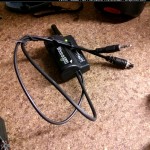
A search for alternate power controlling devices came up blank. No one else was doing it. I think maybe Pocket Wizard was, but their website indicated more menu fuckery to adjust power levels, and fuck me, three hundred bucks per device!? Even if I only replaced my $120-each Radio Poppers I’d be looking at $1500! But if it worked, it worked, and the cost could be absorbed into the photography, though later rather than sooner at that price.
And then I found the Cactus V6.
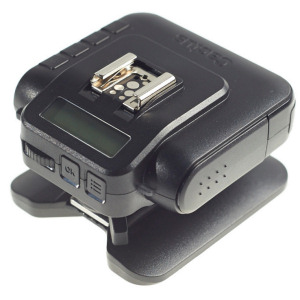
This was a device that did what I wanted, and more. The list of features read like a wishlist of awesome: Four groups of lights, 16 different channels to choose from, digital power control so you could actually see what level the flash was set to, proportionate control of all groups at once, so you could make everything brighter or darker with one flick of the dial. It was, freakishly, amazingly, compatible with lights from Nikon, Canon, and Pentax, and third party lights as well, and if it didn’t know your light specifically, it could be trained to control it and it’d create a profile of its light output. AA batteries instead of expensive CR-123s required by the Radio Poppers. A hot-shoe mount, a tripod socket, and a hot-shoe on top for the speedlight. A headphone-style socket for connecting non-hotshoe devices. Optical triggering, relay capability, holy crap, the list just never stopped.
And they were only $55 each. For the price of one useless Pocket Wizard (you had to have two to even get started) I could get five V6 units, including shipping out of Hong Kong.
And so I ordered five, plus one of Cactus’ new RF60 speedlights, which is a flash with the V6 built in. It’s also brilliant. Summarized, it’s big, powerful, feels weirdly hollow, is built like a tank, and has a radio trigger built in. For $130. Far out. Every other flash manufacturer should have just freaked the fuck out.
Anyway, the V6. Initial impressions were very favourable. It feels solid, not cheap. Everything works. I sat down and fiddled with it, and it did what I expected, the first time, every time. It’s incredibly intuitive, and I was cheerfully enabling, disabling and adjusting the power levels of groups A, B, C and D in seconds. Turn it on, choose a flash profile (Nikon SB-28 in my case) and it’d remember that for next time. Lights indicate the current group, the display indicates the current flash profile and power level (on a receiver) or the four groups and output levels (on the transmitter).
It was like the day I got my Radio Poppers, but in the future. They’re very well made, with exquisite attention to detail. I won’t go on about it, and leave this particular subject with a simple conclusion: as far as quality and build are concerned, the Cactus V6 is top notch. If I might enthuse just a little, they’re fucking brilliant.
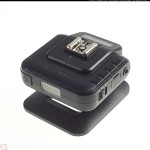
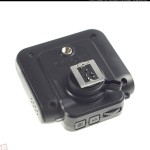
Now, you can read detailed reviews about their operation elsewhere, so I’m only going to touch upon that here.
Tap a group to enable/disable it.
Hold a group and spin the dial to adjust its power (selectable in whole stop, 1/3 stop or 1/10 stop increments).
Absolute control is available, so that you can select an EV number and all lights will output the same amount of light (across brands and models!)
Spin the dial without selecting a group to adjust all groups proportionately.
It’s that easy. It’s not as simple as the Radio Poppers, three analogue knobs to adjust three groups of lights is pretty damned simple. But that simplicity is only decreased fractionally, and the Cactus V6 is worlds better in every other respect.
What’s inside it, you ask? Well, a lot of stuff. That tiny circuit board is jam packed with stuff. I don’t recommend opening it, it’s full of fiddly parts and short ribbon connectors and that spring-loaded battery door is a real bitch to get right when reassembling. But here, Cactus porn:
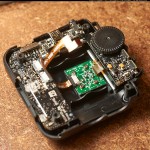
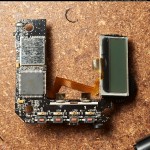
It’s powered by an Atmel Atmega128A3U, and the firmware is upgradeable via the USB port. I’ve talked to Cactus about some issues I’ve had with my Nissin Di866 and SB-800 lights (summary: they work fine but lock the user out of the speedlight’s own control panel while in use by the V6) and they have indicated that the V6 firmware is a work in progress – updates are expected.
It’s very, very well built internally as well. The hotshoes look incredibly robust. This is not a dirty, cheap Chinese trigger. Cactus means business, and I fully expect this device to take the world by storm. I don’t even want to hype these things because I fear they’ll provide amateur losers with the power I have over my lights, but they’re so good I reckon the word will get out anyway, so there you go.
Ahem.
There’s also a standard headphone (3.5mm) socket, and Cactus sell some adaptor cables to interface this with cameras and other devices like studio lights. Power control isn’t available through this socket, however it does offer two-stage activation. The self-test trigger button on every V6 has two stages – a half press and a full press. When used, the receiving V6 LED will turn green with a half press, orange with a full press (and trigger the light, obviously). If you use the headphone port both are available, and so a half-press can be used to signal a camera to focus, and the full press to take the shot.
That’s what I did with my D700, I attached a headphone socket to a remote trigger connector, and can confirm the V6 focuses and fires the D700 easily. Here’s the pinout:
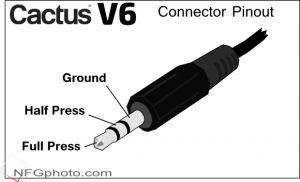
And here are a handful of images showing the V6 in use on a D70s, a D700, and an SB-28 flash. Every V6 comes with its own hot-shoe stand as well, which is nice. In fact, that’s basically all it comes with. The beautiful black box includes the V6, a stand (pre-attached for your convenience), a tiny gallery of photos and light setup, and a tiny manual.
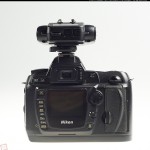
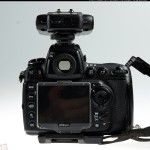
--NFG
[ Oct 3 2015 ]
| Next Post | Navigation | Previous Post |
|---|

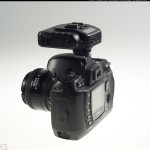

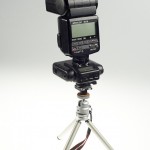
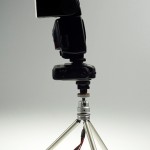


Name:
Email:
Website: